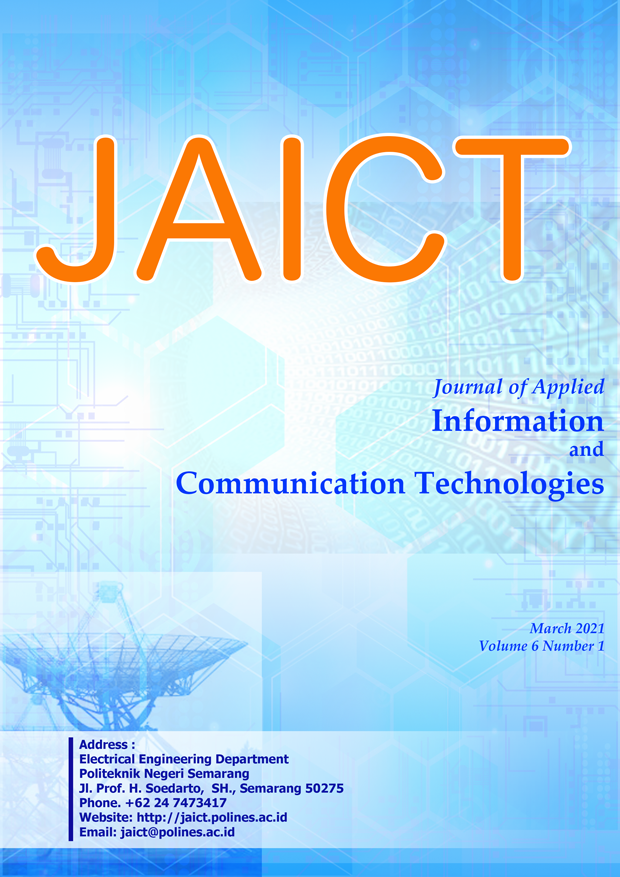Air Quality Monitoring and Decision Support System Using IoT
DOI:
https://doi.org/10.32497/jaict.v6i1.2193Keywords:
Air quality, sensors, IoT, Internet, Pollution,Abstract
Air is one of the most important elements of life for living things in the world. For humans, the air is an element that is very concerned because it is related to health. In Jakarta, the Air Pollution Standard Index (ISPU) is ranked second as the capital city of a country with poor air quality. Air quality in Jakarta is monitored by an Air Quality Index (AQI) of 160 with parameters in the form of very small pollutant particles with a diameter of fewer than 2.8 micrometres (PM 2.8). The purpose of this research is how we make a tool that can determine the quality of the air around us and can be carried (portable) anywhere easily. In accordance with the 4.0 industrial revolution that everything has been integrated with the Internet of Things (IoT) technology where the public can find out the air condition in real-time. In this study, the prototype method is used as a test. The main components are sensors consisting of MQ-6 (CO2 and smoke), MQ-7 (CO, LPG, CH4), MQ135 (Butane, AirQuality), and DHT-11 (Humidity, temperature). From the research that has been done where the air quality in urban areas has a low air quality index by measuring it using a prototype consisting of a gas sensor and Arduino microcontroller, which has been made to produce an average CO2 of 25 ppm, CO 2330 which has exceeded the threshold, while NH3 1.23 and C4H10 1120 are still below the threshold. These values are influenced by pollutants generated by transportation such as motorbikes, cars, and land transportation
References
R. Nayak, M. R. Panigrahy, V. K. Rai, T. A. Rao, and B. Diagram, “IoT Based Air Pollution Monitoring System,” no. 4, pp. 571”“575, 2017.
M. R. Deshmukh, S. J. Chavan, R. A. Chavan, and P. G. Atarde, “IOT Based Air & Sound Pollution Monitoring System,” no. 3, pp. 750”“753, 2018.
A. M. Leman, “Occupational Safety and Health : Workers and Industrial Safety Monitoring For Sustainable Work Industrialisation and urban renewal has caused widespread problems relating to environments such Author Details :,” no. May, pp. 34”“36, 2013.
A. Kurniawati, “DIPONEGORO LAW REVIEW Volume 1, Nomor 2, Tahun 2013,” vol. 1. pp. 1”“11, 2013.
P. Y. Sai, “An IoT Based Automated Noise and Air Pollution Monitoring System,” vol. 6, no. 3, pp. 419”“423, 2017, doi: 10.17148/IJARCCE.2017.6397.
K. Okokpujie, E. Noma-osaghae, and M. Odusami, “A SMART AIR POLLUTION MONITORING,” no. October, 2018.
S. Kaivonen and E. Ngai, “AC,” Digit. Commun. Networks, 2019, doi: 10.1016/j.dcan.2019.03.003.
G. Swagarya, S. Kaijage, and R. S. Sinde, “Air Pollution Monitoring System based on Wireless Networks - Simulation,” vol. 5, no. 8, pp. 9”“16, 2014.
C. Chen, T. Wen, C. Sun, and J. Juang, “A Community Health Service Architecture Based on the Internet of Things on Health-Care,” no. April 2015, 2017, doi: 10.21307/ijssis-2017-477.
B. Carter and R. Ragade, “Message Transformation Services for Wireless Sensor Networks ( MTS-WSN ),” no. January 2006, 2014.
A. Nag, S. C. Mukhopadhyay, and J. Kosel, “Wearable Flexible Sensors : A Review,” no. c, 2017, doi: 10.1109/JSEN.2017.2705700.
J. Blum, Exploring Arduino: Tools and Techniques for Engineering Wizardry. .
Downloads
Published
Issue
Section
License
Authors who publish with this journal agree to the following terms:Authors retain copyright and grant the journal right of first publication with the work simultaneously licensed under a Creative Commons Attribution License that allows others to share the work with an acknowledgement of the work's authorship and initial publication in this journal.
Authors are able to enter into separate, additional contractual arrangements for the non-exclusive distribution of the journal's published version of the work (e.g., post it to an institutional repository or publish it in a book), with an acknowledgement of its initial publication in this journal.
Authors are permitted and encouraged to post their work online (e.g., in institutional repositories or on their website) prior to and during the submission process, as it can lead to productive exchanges, as well as earlier and greater citation of published work (See The Effect of Open Access).






